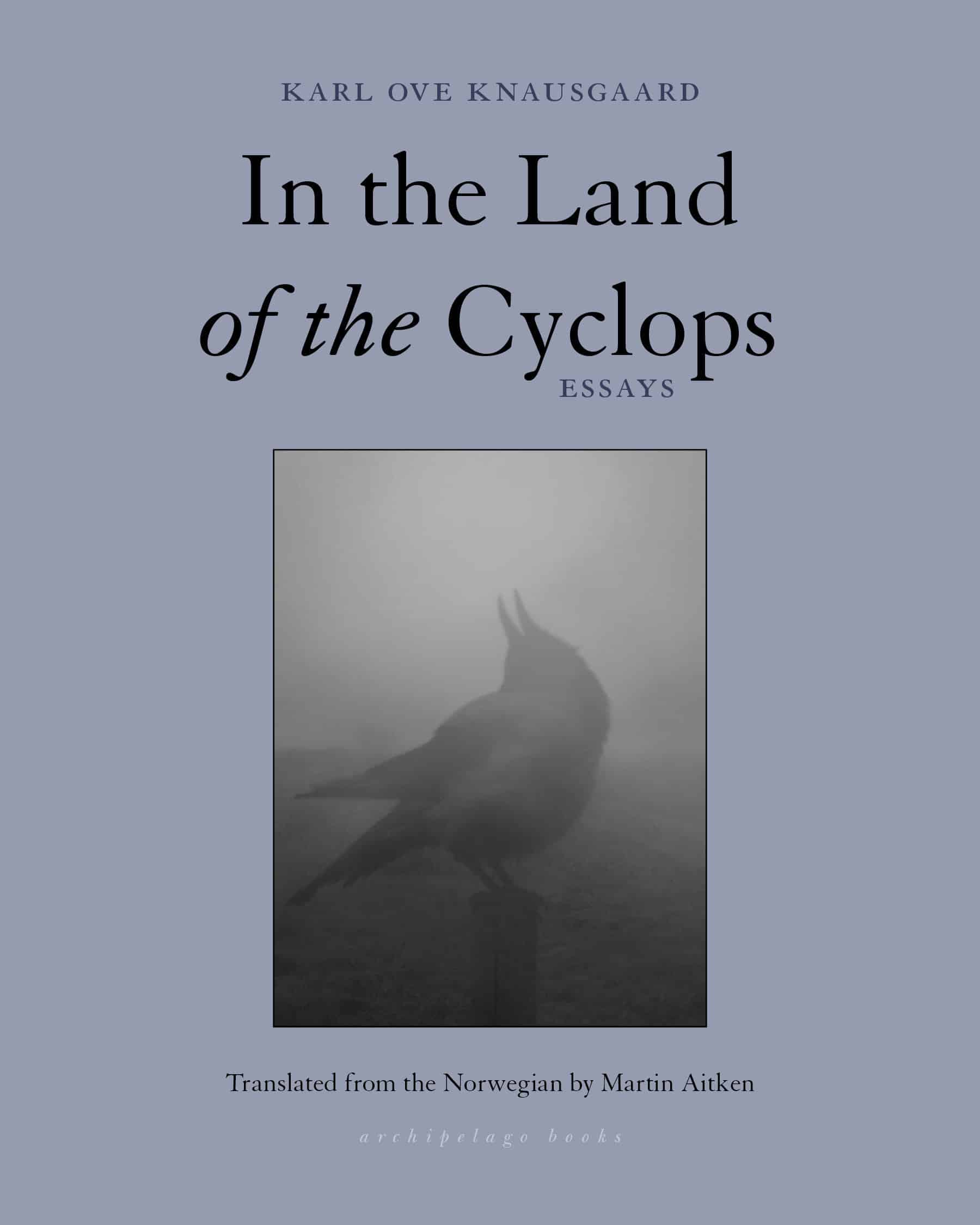In the Land of the Cyclops
| by |
|---|
14.00 JOD
Please allow 2 – 5 weeks for delivery of this item
Description
Knausgaard’s struggle is still ongoing with In the Land of the Cyclops as he continues to navigate the fjord of truth between reality and experience“This, which we perhaps could call inexhaustible precision, is the goal of all art, and its essential legitimacy.” —Jessica Ferri, The Los Angeles TimesIn his first essay collection to be published in English, the New York Times bestselling author of the My Struggle series Karl Ove Knausgaard explores art, philosophy, and literature with piercing candor and remarkable erudition. Paired with full color-images, his essays render the shadowlands of Cindy Sherman’s photography, illuminate the depth of Stephen Gill’s eye, and tussle with the inner mechanics of Ingmar Bergman’s workbooks. In one essay he describes the figure of Francesca Woodman, arms coiled in birch bark and reaching up toward the sky—a tree. In another, he unearths Sally Mann’s photographs of decomposing corpses, so much so that branches and limbs, hair and grass, begin to harmonize.Each essay bristles with Knausgaard’s searing honesty and longing to authentically see, understand, and experience the world.
Additional information
| Weight | 1.02 kg |
|---|---|
| Dimensions | 3.38 × 17.38 × 20.53 cm |
| PubliCanadanadation City/Country | USA |
| by | |
| format | |
| Language | |
| Pages | 350 |
| publisher | |
| Year Published | 2021-1-5 |
| Imprint | |
| ISBN 10 | 1939810744 |
| About The Author | Karl Ove Knausgaard was born in Norway in 1968. His debut novel Out of the World won the Norwegian Critics Prize in 2004 and his A Time for Everything was a finalist for the Nordic Council Prize. My Struggle: Book One was a New Yorker Book of the Year and Book Two was listed among the Wall Street Journal's 2013 Books of the Year. My Struggle is a New York Times Best Seller and has been translated into more than twenty languages. Knausgaard writes regularly for the New York Times Magazine. Translator Bio: Martin Aitken is the acclaimed translator of numerous novels from Danish and Norwegian, including works by Karl Ove Knausgaard, Peter Hoeg, Jussie Adler-Olsen, and Pia Juul. His translations of short stories and poetry have appeared in many literary journals and magazines. In 2012 he was awarded the American-Scandinavian Foundation's Nadia Christensen Translation Prize. In 2019 he was awarded the PEN Translation Prize for his translation of Love by Hane Orstavik, which was also a finalist for the National Book Award in 2018. |
". . . A modern Roland Barthes . . . Knausgaard has a gift for stopping the reader in their tracks with an unexpected, casual profundity." — Meghan O'Gieblyn, The New York Times Book Review "…As in the fiction, [Knausgaard's] intense focus, formidable command of reference and tendency to see the interconnectedness of things make for highly stimulating, almost overwhelming reading . . . The pantomime of critical dispassion is avoided; the rhetorical effect is one of wisdom gained rather than merely delivered." —Charles Arrowsmith, the Washington Post"Knausgaard is less interested in answers than in authentic engagement with the world . . . In the Land of the Cyclops is another worthy addition to Knausgaard’s oeuvre that aims to recapture this intense feeling and to see the world anew." —Phillip Garland, World Literature Today"I appreciate Knausgaard revealing his unflattering first impression, then interrogating it, his willingness to go further, to look again, and to show how his mind moves, then changes . . . I want to see what Knausgaard sees, even when I’m overwhelmed by it or disagree . . . Boring down into any moment, thought, or artwork, offers its own thrilling spectacle. You don’t want to look away." — Bridget Quinn, Hyperallergic"The collection, which also includes essays on Michel Houellebecq, Cindy Sherman and Kierkegaard, reads less like a book of criticism at times than a work of negative theology, circling the mysteries of artistic creation that cannot be directly articulated: What makes a book or a painting feel alive and relevant? Why should art, which occupies the realm of pure fantasy, have any rules at all?" — Stephen Poole, The Telegraph "Knausgaard’s passion for interiority and the detail of the individual experience, the most brilliant elements of his fiction, come through . . . “In the Land of the Cyclops” proves that Knausgaard’s struggle is still ongoing, the search for truth as a balance between reality and our experience of it: “This, which we perhaps could call inexhaustible precision, is the goal of all art, and its essential legitimacy.”" — Jessica Ferri, The Los Angeles Times"Knausgaard argues that art is at its most effective when it destabilizes our understanding of the world…The moody, provocative black-and-white photos of Francesca Woodman reveal the “constraints of our culture and what they do to our identity” while Michel Houellebecq’s novel Submission succeeds because it suggests how easily disillusioned people might accept political upheaval, asking “What does it mean to be a human being without faith?”…The throughline is the author’s keen, almost anxious urge to understand the artistic mind." — Kirkus Reviews"In this . . . thought-provoking essay collection, Knausgaard once again displays his knack for raising profound questions about art and what it means to be human . . . These wending musings will be catnip for Knausgaard’s fans. " — Publishers Weekly"Karl Ove Knausgaard explores the realm of the aesthetic where it overlaps with the quotidian in fact as he has in fiction . . . Much insight awaits any sifting through these disparate compositions . . . Knausgaard transforms the everyday into a portal of deep insight." — John L. Murphy, Spectrum Culture More Praise for Knausgaard's work: • Intense and vital…Knausgaard is utterly honest, unafraid to voice universal anxieties…Superb, lingering, celestial passages…[with] what Walter Benjamin called the "epic side of truth, wisdom."-James Wood, The New Yorker • As Jeffrey Eugenides so marvelingly put it, [Knausgaard] broke the sound barrier of the autobiographical novel…There's something primitive and hungry in that experience-and for me, sometimes, something spiritual, close to the exprience of grace. – Charles Finch, Slate • What's notable is Karl Ove's ability, rare these days, to be fully present in and mindful of his own existence…as if the writing and the living are happening simultaneously…it immerses you totally. You live his life with him. – Zadie Smith, New York Review of Books • …so aesthetically forceful as to be revolutionary – Jesse Barron, The Paris Review • My Struggle is a revolutionary novel that is highly approachable, even thrilling to read. The book feels like a masterpiece-one of those genuinely surprising works that alters the tradition it inherited. – Meghan O'Rourke, Bookforum • The book kept me up until two almost every morning for a week…Real and singleminded in his storytelling." – Lorin Stein, The Paris Review • Questions about precisely what fiction is and how it relates to reality and the extend to which traditional narrative can be a delivery vehicle for saying something true about life…lie at the intellectual and aesthetic heart of Knausgaard's huge undertaking. – Daniel Mendelsohn, The New York Times • Knausgaard succeeds in producing prose that is "alive"…Such transgressive blurring of the borders between the public and private, sayable and unsayable, can be both life-affirming and riveting. – The Economist • For all its complexity, My Struggle achieves something pretty simple,the thing that enduring fiction has always done: it creates a world that absorbs you utterly…[Book Six] is alive. – Theo Tait, Sunday Times • Who'd have thought that the first monumental literary production of the 21st century…would seem, on a line-by-line basis, so modest and so raw? The books in the My Struggle series fly high by flying low, by scanning the intricate topography of everyday life. – Dwight Garner, The New York Times • This deserves to be called perhaps the most significant literary enterprise of our times. – Rachel Cusk, The Guardian • How wonderful to read an experimental novel that fires every nerve ending while summoning in the reader the sheer sense of how amazing it is to be alive, on this planet and no other. – Jeffrey Eugenides, The New York Times Book Review |
|
| Other text | Knausgaard broke the sound barrier of the autobiographical novel. — Jeffrey Eugenides KARL OVE KNAUSGAARD. MY STRUGGLE. It’s unbelievable. I just read 200 pages of it and I need the next volume like crack. — Zadie Smith |
| Excerpt From Book | ALL THAT IS IN HEAVEN. A few days ago a picture appeared in a number of newspapers online, it was from a medical examination, an ultrasound image of a man’s testicles; there was a face in there as clear as day, with eyes, a nose and mouth, a child gazing disconcertedly out of its darkness in the depths of the body. The phenomenon is not uncommon and has often been associated with Christ, perhaps because only his face makes such occurrences noteworthy enough to report on. The face of Jesus can appear in a marble cake, a slice of burnt toast, a stained piece of fabric. Last autumn I was stopped by a woman on the street in Gothenburg, she wanted to give me a photograph of Christ seen in a rock face somewhere in Sweden. These viral images are not vague schemata filled in by vivid imaginations, but utterly convincing; the face staring out of the man’s testicles is incontestably that of a child, and the male figure in the rock face, his hand held up in a gesture of peace, is incontestably an image of Jesus Christ exactly as he has been iconised. This is so because the forms that occur in the world are constrained in number, and the human face and body are one such form. They can just as easily appear in a pile of sand as in a pile of cells. If you lie on your back and look up at the sky on a summer’s day, hardly a few minutes will pass before you see a recognisable shape in the clouds. A hare, a bathtub, a mountain, a tree, a face. These images are not constant; slowly they transform and turn into something else, as opposed to the person lying there looking at them, whose face and body remain unchanged, and to the natural surroundings from which they are observed: the ground with its grass and trees, they too remain unchanged. But the immutable is only seemingly so, for the face, the body, the grass and the trees change too, and if we return to the same spot, this clearing in the forest, fifteen years later, it will be completely different and the face and body will also have changed, albeit not unrecognisably so. However, in the greater perspective of time they too will change; over a two-hundred-year period the face and body will have arisen, formed, deformed and dissolved in sequences of change not unlike those undergone by the clouds, though far more slowly since they take place in the denseness of the flesh rather than in the vaporous firmament. That we do not see the world in this way, as matter at the mercy of all-destructive forces, is only because that perspective is not available to us, our being confined within our own human time as it were, viewing all change from that vantage point only. We see the changes in the clouds, but not the changes in the mountains. On this basis we form our conceptions of the immutable and immutability, of change and changeability. We retain in our minds the form of the mountain as it appeared to us the day we stood in front of it, but not the forms of the clouds that were above the mountain at that same moment. Our body exists somewhere in between these monitors of mutability that measure the speed of our lives. Our own time, the change we are able to register as we stand here in the midst of the world, is, apart from the movements of the body, almost always bound up with water and wind. The raindrops that drip from the gutter, the leaf whirled into the air, the clouds that slip over the ridge, the water that trickles towards the stream, the river that runs into the sea, the waves that form and break apart in an ever-changing abundance of unique forms. We can see this, for the time in which such movement occurs is synchronised with that of our own existence. We refer to that time as the now. And what happens within us in the now is not dissimilar to what happens outside us, a continual formation and breaking apart that never ceases as long as we live: our thoughts. On the sky of the self they come drifting, each unique, and over the precipice of oblivion they vanish again, never to return in the same shape. The idea of a connection between our thoughts and the clouds, between the soul and the sky, is ancient and has always been opposed, or restrained, by the connection between the body and the earth. That which is fleeting, ethereal and free has always been eternal; that which is firm, material and bound has always been transient. With the breakthrough of modern science in the seventeenth century, which pushed back the limitations of the human eye with the invention of the microscope and the telescope, an era in the western world in which the human body began to be systematically dissected, one of the greatest challenges to arise concerned the nature of thought in this system of cells and nerves. Where was the soul in this mannequin of muscles and tendons? The French philosopher Descartes performed dissections in his apartments in Amsterdam, striving to find the seat of the soul, which he believed to be found in one of the glands, and to trace human thought, which he believed to be conducted through the tiny tubes of the brain. Science has come no closer to pinning down these concepts in the three hundred or so years that have passed since Descartes made his investigations, for the distinction between the I who says I think, therefore I am, and the brain in which that sentence is conceived and thought, and from which it is then issued, that biological-mechanical welter of cells, chemistry and electricity, is immeasurable, as one of Descartes’ contemporaries only a few city blocks away, the painter Rembrandt, demonstrates in one of his dissection pictures where the upper part of the skull has been removed, held forth like a cup by an assistant while the physician himself cautiously cuts into the exposed brain of the corpse. No thought, only the tubes of thought; no soul, only its empty casing. What were thought and the soul? They were what stirred inside. In his essay collection Descartes’ Devil: Three Meditations, a substantial and near-fuming apologia for Descartes, the German poet Durs Grünbein writes about one of the Baroque philosopher’s dissections of an ox in whose eye Descartes claimed to have seen an image of what the ox itself had seen in its final seconds of life. Descartes writes: “We have seen this picture in the eye of a dead animal, and surely it appears on the inner skin of the eye of a living man in just the same way.” Of this strange idea, Grünbein writes: “Descartes, who imagines the retina as a sheet of paper, as thin and transluscent as an eggshell, really believes that something seen is, as it were, imprinted on it.” |
Only logged in customers who have purchased this product may leave a review.
Related products
-
On backorder 2-5 Weeks to Arrive
120.00 JOD -
On backorder 2-5 Weeks to Arrive
-
On backorder 2-5 Weeks to Arrive
-
On backorder 2-5 Weeks to Arrive
36.99 JOD






Reviews
There are no reviews yet.